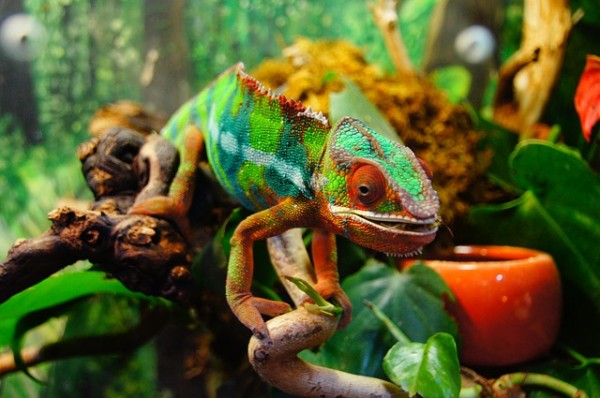How Does a Chameleon Change its Colors? It's All About Crystals
| Ana Verayo | | Mar 11, 2015 06:25 AM EDT |
A Yemen chameleon shows off its dazzling array of colors.
The chameleon's unique ability to change color is apparently caused by structural changes found within their skin cells that involve nanocrystals, said researchers from the University of Geneva.
Chameleons, especially males, can change their colors in a matter of seconds to attract a female and also ward off other male competitors.
Like Us on Facebook
Most zoologists have traditionally believed this tiny animal's ability lies in activating melanosomes in their bodies. Melanosomes are pigment filled cells embedded inside their skin cells.
Many animals rely on color changing or the dispersion of pigments to change their appearance. In chameleons, however, changing color isn't apparently caused by color-filled cells under their skin but rather by nanocrystals reflecting light.
According to Michel Milinkovitch, a professor of evolution and genetics from the University of Geneva, these colors are generated without the use of pigments.
Scientists said the chameleon's dazzling array of colors, ranging from emerald green to yellow ochre accompanied by ruby red hues and aquamarine blues, are caused by nanocrystals made from pure guanine, which is a component of DNA.
Researchers believe chameleons can actively manipulate these nanocrystals on the outer layer of skin cells known as iridophores. Another deeper layer of cells possesses larger crystals but are arranged in a less orderly way. These reflect infrared light.
These two superimposed layers allow chameleons to quickly change from an efficient greenish camouflage to an amazing array of colors.
Study authors, Jeremie Teyssier, a physicist, and biologist Suzanne Saenke said chameleons change their colors when they actively tune a lattice of nanocrystals.
They also add that when a chameleon is relaxed, the lattice is organized into a dense network and reflects blue wavelengths. When the aniamal becomes excited, the nanocrystals allow the lattice to reflect other colors like yellows and reds.
The process as to how chameleons change and control these crystal structures is still yet to be deciphered, however. Researchers suggest it could involve swelling or shrinking these cells to generate a guanine lattice.
This study was published in Nature Communications.
TagsHow Does a Chameleon Changes its Colors? It's All About Crystals, chameleons, crystals colors changing chameleon ability, chameleon camouflage, how does a chameleon changes its colors
©2015 Chinatopix All rights reserved. Do not reproduce without permission
EDITOR'S PICKS
-

Did the Trump administration just announce plans for a trade war with ‘hostile’ China and Russia?
-

US Senate passes Taiwan travel bill slammed by China
-

As Yan Sihong’s family grieves, here are other Chinese students who went missing abroad. Some have never been found
-

Beijing blasts Western critics who ‘smear China’ with the term sharp power
-

China Envoy Seeks to Defuse Tensions With U.S. as a Trade War Brews
-

Singapore's Deputy PM Provides Bitcoin Vote of Confidence Amid China's Blanket Bans
-

China warns investors over risks in overseas virtual currency trading
-

Chinese government most trustworthy: survey
-

Kashima Antlers On Course For Back-To-Back Titles
MOST POPULAR
LATEST NEWS
Zhou Yongkang: China's Former Security Chief Sentenced to Life in Prison

China's former Chief of the Ministry of Public Security, Zhou Yongkang, has been given a life sentence after he was found guilty of abusing his office, bribery and deliberately ... Full Article
TRENDING STORY

China Pork Prices Expected to Stabilize As The Supplies Recover

Elephone P9000 Smartphone is now on Sale on Amazon India

There's a Big Chance Cliffhangers Won't Still Be Resolved When Grey's Anatomy Season 13 Returns

Supreme Court Ruled on Samsung vs Apple Dispute for Patent Infringement

Microsoft Surface Pro 5 Rumors and Release Date: What is the Latest?










